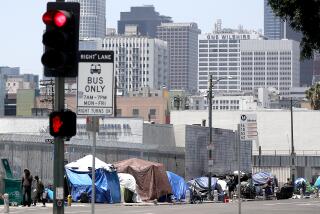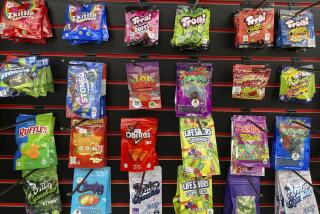The Bright, Dark Side of Drug Use by Adolescents
- Share via
WASHINGTON — Illicit drug use by U.S. adolescents declined last year for the first time since 1992, and the Clinton administration heralded the improvement as “the beginning of an arrest of the astronomical level of drug use among our children.”
The rate of drug use among youths ages 12 to 17 fell from 10.9% in 1995 to 9.0% in 1996, according to the 1996 National Household Drug Survey released Wednesday by the Health and Human Services Department.
But the bright picture was marred by several factors, including more first-time heroin use among teenagers, increased use of hallucinogens, fewer teens believing cocaine is harmful and little change in cigarette smoking.
Use of illicit drugs, alcohol and tobacco among Americans of all ages held steady at 6.1%, with slight increases in cocaine and cigarette use and small decreases for hallucinogens, alcohol and smokeless tobacco. Marijuana and heroin use remained constant.
Gen. Barry R. McCaffrey, administration drug czar, said the decrease in teens reporting marijuana use in the past month represents “tentative good news.” Although the decline, from 8.2% in 1995 to 7.1% in 1996, is slight, he said it could signal a “leveling-off” for marijuana, the primary drug abused by youth. Marijuana use among teens had more than doubled since 1992.
Alcohol use declined from 21.1% in 1995 to 18.8% in 1996. The use of smokeless tobacco products, such as snuff, declined substantially, from 2.8% in 1995 to 1.9% in 1996, the survey said.
“These findings on teen drug use offer a glimmer of hope, but they also remind us that we cannot rest in our efforts against drugs,” said HHS Secretary Donna Shalala, who joined McCaffrey in releasing the report.
Shalala said illicit drug use is “still unacceptably high.”
The percentage of teens reporting use of hallucinogens has nearly doubled in the last two years, according to the survey. In 1996, 2% of teens reported using the drugs, up from 1.1% in 1994 and 1.7% in 1995.
Among all Americans, 141,000 tried heroin for the first time in 1995, the most recent year for that statistic. First-time heroin use has been increasing substantially, rising from 40,000 new users in 1992. The average age for first-time users is 19.3, down from 25 just eight years ago. Most first-time users are teenagers, 25% of whom said heroin is easy to obtain.
“It’s availability and purity [have] gone up and price has gone down. We’re seeing the use of heroin in younger people. . . . Alarm is appropriate,” McCaffrey said.
Cigarette use declined slightly, from 20.2% in 1995 to 18.3% in 1996. The survey found a strong link between use of cigarettes and other drugs, with youths who smoke nine times as likely to use illicit drugs and 16 times as likely to drink heavily as nonsmoking youths.
McCaffrey and Shalala emphasized the importance of examining adolescents’ attitudes about drugs, as well as actual usage patterns. They expressed particular concern that fewer teens believe there is “great risk” in using cocaine once a month; the percentage expressing that view has fallen from 63% in 1994 to 54% in 1996.
Shalala said adolescents need to be given clear messages about the dangers of drug use from parents, coaches, clergy and the media.
“Too many adults in their lives still haven’t sat them down, looked them straight in their eyes and said, ‘No, drugs are not cool. Drugs are not safe. Drugs will rip apart your family and kill your dreams,’ ” she said.
(BEGIN TEXT OF INFOBOX / INFOGRAPHIC)
Youth Drug Use
Percentage of youths 12-17 reporting illicit drug use:
1996: 9.0%
Source: National Household Survey on Drug Abuse
More to Read
Sign up for Essential California
The most important California stories and recommendations in your inbox every morning.
You may occasionally receive promotional content from the Los Angeles Times.












